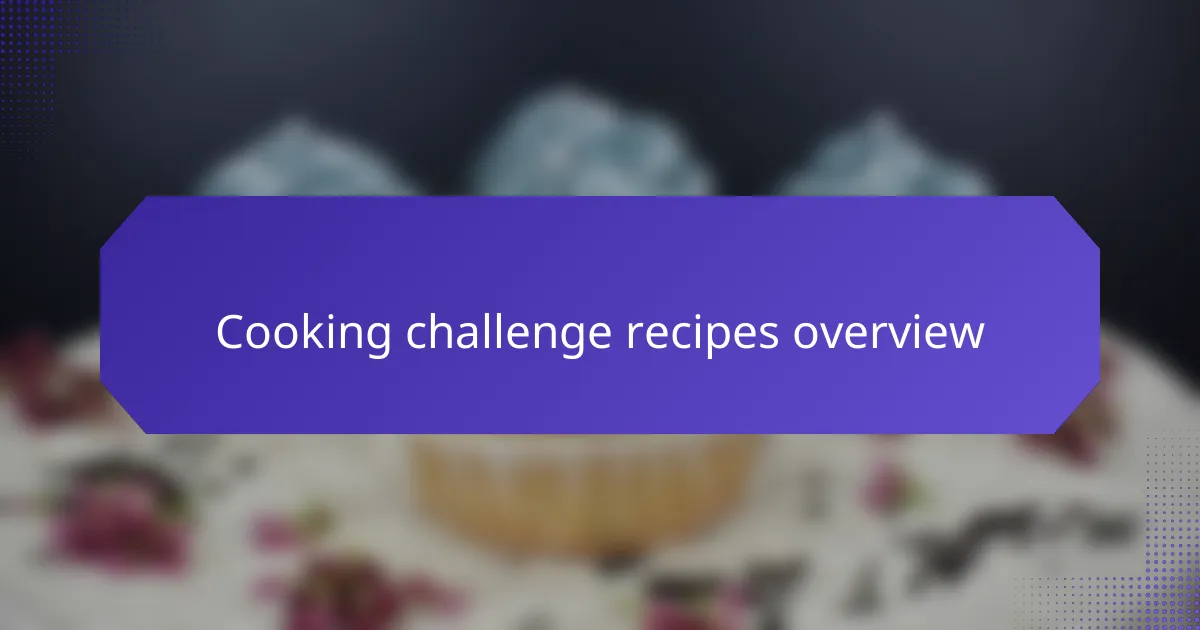Key takeaways
- Cooking challenges enhance creativity and foster connections in the kitchen.
- Pillsbury dough offers a convenient, consistent, and versatile option for pie crusts, making baking easier.
- Chilling tools and ingredients, along with adding salt, can significantly improve the texture and flavor of pie crusts.
- Presentation and flavor pairings can elevate the pie experience, making it a memorable part of gatherings.

Cooking challenge recipes overview
Cooking challenges can be a delightful way to explore your culinary skills and boost your confidence in the kitchen. I remember my first cooking challenge; it felt like a ticket to a delicious adventure. There’s something exciting about experimenting with recipes and watching how simple ingredients transform into something extraordinary.
When it comes to crafting the perfect pie crust, starting with pre-made options like Pillsbury dough can save time and reduce stress, especially during a challenge. I can recall once using their dough for a spontaneous baking session with friends—it turned out to be a fun bonding experience, filled with laughter and tasty rewards. Here’s a quick overview of what makes a cooking challenge recipe thrilling and accessible:
- Encourages creativity and experimentation
- Reduces intimidation for beginner cooks
- Fosters connection and shared experiences with others
- Allows for delicious results even with shortcuts
- Perfect for themed parties or gatherings

Essential ingredients for pie crust
When I think about what makes up the perfect pie crust, using Pillsbury dough always brings back memories of baking with my grandmother. She taught me that while convenience is key, the quality of ingredients still matters. With Pillsbury, you’re getting a ready-made option that balances taste and texture perfectly.
Here’s a quick list of essential ingredients to have on hand for a great pie crust:
- Pillsbury refrigerated pie crust
- All-purpose flour (for dusting and a bit of extra texture)
- Granulated sugar (to add a hint of sweetness)
- Salt (to enhance flavor)
- Butter (optional, but I like to add a bit for richness)
These ingredients not only work well together but also allow for the kind of flexibility I love in my baking adventures.

Benefits of using Pillsbury dough
Using Pillsbury dough for your pie crust is a game-changer. From my experience, it saves time without sacrificing flavor. The convenience of having pre-made dough on hand means I can focus more on the filling and creative aspects of my pie, making baking less stressful.
One aspect I particularly appreciate is the consistent texture that Pillsbury dough provides. Every time I roll it out, I know I’m going to get that flaky, buttery finish that makes each pie slice irresistible. Plus, it’s incredibly versatile; whether I’m making a savory quiche or a sweet dessert pie, it always delivers amazing results.
Another benefit I’ve noticed is the ease of use. I’ve hosted many dinner parties where the crust was the star, and my guests were surprised to learn I didn’t make the dough from scratch. Using Pillsbury not only impresses my friends but also gives me more time to spend with them instead of stuck in the kitchen.
| Benefit | Pillsbury Dough |
|---|---|
| Time-saving | Ready to roll, no mixing required |
| Consistency | Uniform texture every time |
| Versatility | Works for sweet and savory recipes |
| Ease of Use | Simple for bakers of all levels |

Step by step pie crust preparation
When it comes to preparing a pie crust with Pillsbury dough, I’ve learned that a few simple steps can lead to a delightful result. First, I always make sure to let the dough sit at room temperature for about 10-15 minutes. This makes it easier to roll out without cracking. I found that taking this little extra time not only creates a smoother experience but also results in a more even crust once it’s baked.
Next, I gently roll the dough on a floured surface, being careful to maintain an even thickness. I remember the first time I tried this, I was a bit nervous and ended up with an uneven crust. But with practice, I’ve come to appreciate the beauty of a perfectly rolled dough that fits my pie dish just right. It’s about enjoying the process as much as the end result.
Finally, I make sure to lightly prick the bottom of the crust with a fork before blind baking. This prevents bubbles and ensures that the texture is just right. After all, there’s nothing quite like the joy of pulling a perfectly golden pie crust out of the oven, filled with my favorite ingredients!
| Step | Description |
|---|---|
| Let it Rest | Allow the dough to sit at room temperature for 10-15 minutes. |
| Roll it Out | Roll the dough out on a floured surface to even thickness. |
| Prick the Base | Gently pierce the bottom with a fork before blind baking. |

Tips for perfecting pie crust
One of the key tips I’ve picked up over the years is to keep your tools and ingredients cold. I remember my grandmother always swore by chilling everything—her rolling pin, the bowl, and even her hands! This simple trick helps to maintain that flaky texture we all crave in a pie crust. The colder the fat in your dough, the better your crust will turn out, so don’t skip this step.
Don’t underestimate the power of a pinch of salt. It’s amazing how a small amount can enhance the overall flavor of your crust. I learned this the hard way after making a crust once without it—I was left with a bland base that did nothing for my filling. Even just a teaspoon or so can elevate the taste dramatically, transforming your pie from forgettable to memorable.
Lastly, I always recommend letting your pie crust rest in the fridge for at least 30 minutes before baking. I’ve found that it helps to relax the gluten, leading to a more tender crust. After a few successful attempts at this, I can confidently say that the wait is worth it. Think of it this way: good things come to those who wait—and that definitely includes great pie crust!

Personal experiences with pie crust
When I first tackled making pie crusts, I felt a mixture of excitement and anxiety. I remember my initial attempts were a tad overwhelming, with flour everywhere and a dough that refused to cooperate. But then I discovered Pillsbury dough, and it was a game-changer. The ease of using it made me appreciate pie-making even more, transforming a stressful task into a delightful experience.
I often find myself reminiscing about the holidays when my family would gather around the kitchen. We’d chat and laugh as we peeled apples or rolled out the dough together. With Pillsbury, it felt like I could capture that nostalgia without the mess. I gained confidence in my baking, knowing that with just a few simple steps, the perfect crust was within reach, evoking both joy and tasty memories.
Here’s a table comparing traditional pie crusts and Pillsbury dough:
| Traditional Pie Crust | Pillsbury Dough | |
|---|---|---|
| Time Required | More time-consuming | Quick and easy |
| Skill Level | Requires practice | Beginner-friendly |
| Mess Factor | High, involves flour | Low, minimal cleanup |
| Flavor | Customizable | Consistent and delicious |

Serving suggestions for pie dishes
When it comes to serving pie, presentation can elevate the entire experience. I find that a simple dusting of powdered sugar or a drizzle of caramel sauce can transform a slice into something truly special. Have you ever noticed how a small touch can turn an ordinary dessert into a showstopper? I once garnished a warm apple pie with a scoop of vanilla ice cream, and watching it slowly melt over the crust was a moment of pure joy for my guests.
Pairing your pie with complementary flavors adds another layer of enjoyment. For instance, a rich chocolate pie works beautifully with freshly whipped cream or a sprinkle of sea salt. I remember hosting a dinner party where I served mint chocolate pie alongside a fresh mint tea. The combination not only delighted the palate but also made for a lovely presentation. It’s all about creating connections through flavor!
Don’t overlook the serving method—sometimes, simplicity is key. I often serve my pies right from the dish they were baked in, emphasizing a homemade feel. I also like to use a warm pie plate to keep the dessert cozy as it makes its way to the table. It’s such a warm touch that enhances the comforting vibe of a homemade dessert. After all, isn’t that what we all want when we gather around the table?


